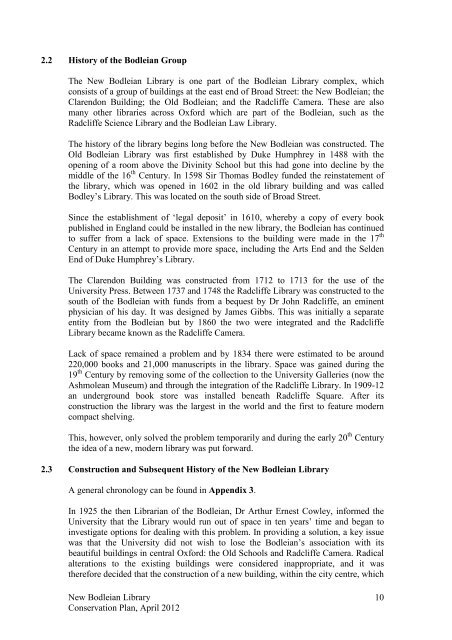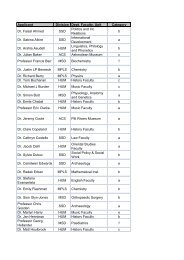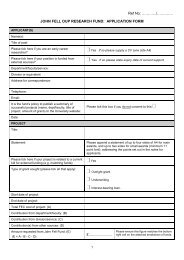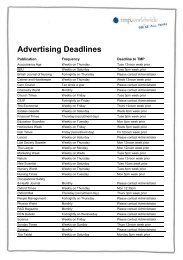The New Bodleian Library Conservation Plan - Central ...
The New Bodleian Library Conservation Plan - Central ...
The New Bodleian Library Conservation Plan - Central ...
- No tags were found...
You also want an ePaper? Increase the reach of your titles
YUMPU automatically turns print PDFs into web optimized ePapers that Google loves.
2.2 History of the <strong>Bodleian</strong> Group<strong>The</strong> <strong>New</strong> <strong>Bodleian</strong> <strong>Library</strong> is one part of the <strong>Bodleian</strong> <strong>Library</strong> complex, whichconsists of a group of buildings at the east end of Broad Street: the <strong>New</strong> <strong>Bodleian</strong>; theClarendon Building; the Old <strong>Bodleian</strong>; and the Radcliffe Camera. <strong>The</strong>se are alsomany other libraries across Oxford which are part of the <strong>Bodleian</strong>, such as theRadcliffe Science <strong>Library</strong> and the <strong>Bodleian</strong> Law <strong>Library</strong>.<strong>The</strong> history of the library begins long before the <strong>New</strong> <strong>Bodleian</strong> was constructed. <strong>The</strong>Old <strong>Bodleian</strong> <strong>Library</strong> was first established by Duke Humphrey in 1488 with theopening of a room above the Divinity School but this had gone into decline by themiddle of the 16 th Century. In 1598 Sir Thomas Bodley funded the reinstatement ofthe library, which was opened in 1602 in the old library building and was calledBodley’s <strong>Library</strong>. This was located on the south side of Broad Street.Since the establishment of ‘legal deposit’ in 1610, whereby a copy of every bookpublished in England could be installed in the new library, the <strong>Bodleian</strong> has continuedto suffer from a lack of space. Extensions to the building were made in the 17 thCentury in an attempt to provide more space, including the Arts End and the SeldenEnd of Duke Humphrey’s <strong>Library</strong>.<strong>The</strong> Clarendon Building was constructed from 1712 to 1713 for the use of theUniversity Press. Between 1737 and 1748 the Radcliffe <strong>Library</strong> was constructed to thesouth of the <strong>Bodleian</strong> with funds from a bequest by Dr John Radcliffe, an eminentphysician of his day. It was designed by James Gibbs. This was initially a separateentity from the <strong>Bodleian</strong> but by 1860 the two were integrated and the Radcliffe<strong>Library</strong> became known as the Radcliffe Camera.Lack of space remained a problem and by 1834 there were estimated to be around220,000 books and 21,000 manuscripts in the library. Space was gained during the19 th Century by removing some of the collection to the University Galleries (now theAshmolean Museum) and through the integration of the Radcliffe <strong>Library</strong>. In 1909-12an underground book store was installed beneath Radcliffe Square. After itsconstruction the library was the largest in the world and the first to feature moderncompact shelving.This, however, only solved the problem temporarily and during the early 20 th Centurythe idea of a new, modern library was put forward.2.3 Construction and Subsequent History of the <strong>New</strong> <strong>Bodleian</strong> <strong>Library</strong>A general chronology can be found in Appendix 3.In 1925 the then Librarian of the <strong>Bodleian</strong>, Dr Arthur Ernest Cowley, informed theUniversity that the <strong>Library</strong> would run out of space in ten years’ time and began toinvestigate options for dealing with this problem. In providing a solution, a key issuewas that the University did not wish to lose the <strong>Bodleian</strong>’s association with itsbeautiful buildings in central Oxford: the Old Schools and Radcliffe Camera. Radicalalterations to the existing buildings were considered inappropriate, and it wastherefore decided that the construction of a new building, within the city centre, which<strong>New</strong> <strong>Bodleian</strong> <strong>Library</strong><strong>Conservation</strong> <strong>Plan</strong>, April 201210
















